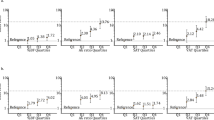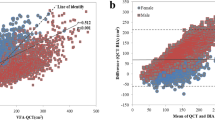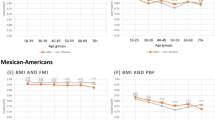Abstract
OBJECTIVE: To investigate whether the dual-energy X-ray absorptiometry (DEXA) was a better predictor of abdominal fat, measured by magnetic resonance imaging (MRI) at the level of L2-L3, than anthropometric measurements in non-obese men and non-obese women.
DESIGN: Observational, cross sectional study.
SUBJECTS: 34 healthy subjects (17 men and 17 women) aged 20–53 y with a body mass index (BMI) <30 kg/m2.
MEASUREMENTS: Fat distribution parameters including waist circumference and waist-to-hip ratio (WHR); intra abdominal fat (IAF) by MRI; and central abdominal fat (CAF) by DEXA.
RESULTS: Measurement of IAF by MRI, was highly correlated to the CAF measured by DEXA. In men, both waist circumference and WHR had similar correlation to IAF as DEXA. In women, waist circumference was less well correlated with IAF than DEXA, and the WHR had a weaker non significant correlation with IAF.
CONCLUSIONS: In non obese men; DEXA, waist circumference and WHR can predict IAF equally well, while in non obese women, DEXA is superior to waist circumference and much better than WHR.
This is a preview of subscription content, access via your institution
Access options
Subscribe to this journal
Receive 12 print issues and online access
$259.00 per year
only $21.58 per issue
Buy this article
- Purchase on Springer Link
- Instant access to full article PDF
Prices may be subject to local taxes which are calculated during checkout
Similar content being viewed by others
Author information
Authors and Affiliations
Rights and permissions
About this article
Cite this article
Kamel, E., McNeill, G., Han, T. et al. Measurement of abdominal fat by magnetic resonance imaging, dual-energy X-ray absorptiometry and anthropometry in non-obese men and women. Int J Obes 23, 686–692 (1999). https://doi.org/10.1038/sj.ijo.0800904
Received:
Revised:
Accepted:
Published:
Issue Date:
DOI: https://doi.org/10.1038/sj.ijo.0800904
Keywords
This article is cited by
-
The waist-to-body mass index ratio as an anthropometric predictor for cardiovascular outcome in subjects with established atherosclerotic cardiovascular disease
Scientific Reports (2022)
-
Comparison of body composition parameters in the study of the association between body composition and pulmonary function
BMC Pulmonary Medicine (2021)
-
Age- and sex-specific visceral fat reference cutoffs and their association with cardio-metabolic risk
International Journal of Obesity (2021)
-
Evaluation of body composition using dual-energy X-ray absorptiometry in patients with non-functioning adrenal incidentalomas and an intermediate phenotype: Is there an association with metabolic syndrome?
Journal of Endocrinological Investigation (2019)
-
Beyond BMI: How to Capture Influences from Body Composition in Health Surveys
Current Nutrition Reports (2016)



